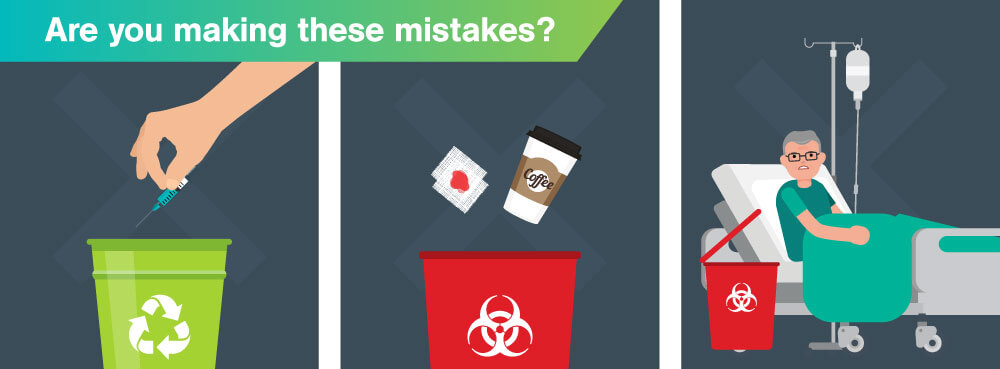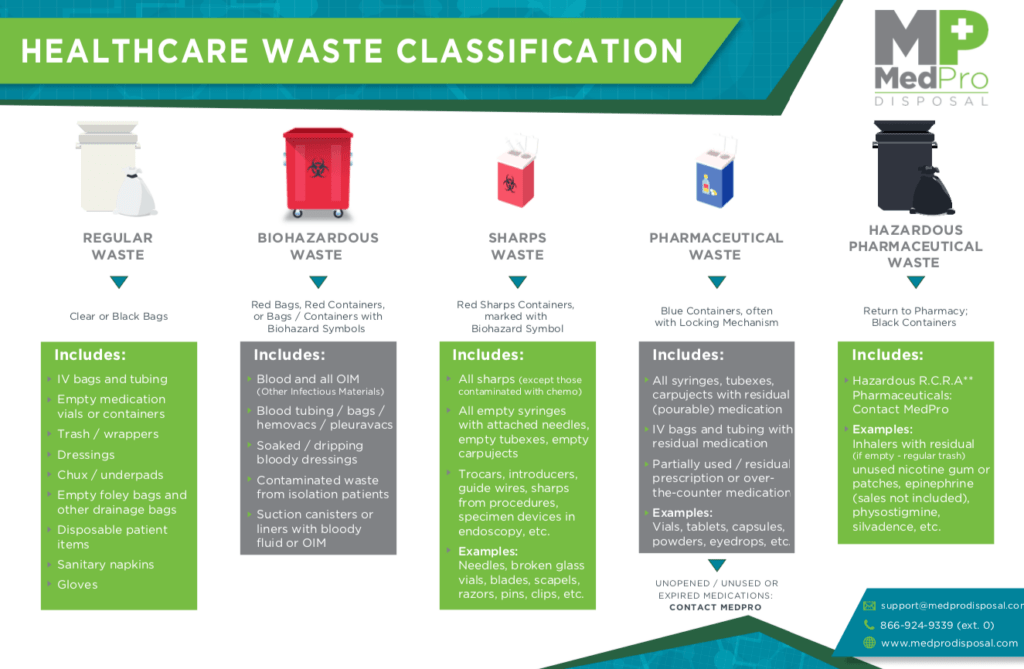Strategic Medical Waste Disposal Solutions: Supporting Safety and Sustainability
Wiki Article
Lasting Solutions for Medical Waste Disposal
The correct administration and disposal of clinical waste is important in maintaining a secure and sustainable health care system. This intro will check out various sustainable services for medical waste disposal, consisting of waste partition and sorting, on-site waste treatment systems, recycling and reuse programs, waste-to-energy conversion modern technologies, as well as collaboration and education efforts.Waste Segregation and Sorting
The process of waste partition and sorting is essential in ensuring proper administration and disposal of clinical waste. Clinical waste is classified into different classifications based upon its possible risk to human wellness and the atmosphere. Appropriate partition and sorting of waste aid to lessen the risk of contamination and make sure that each kind of waste is managed and disposed of appropriately.The very first step in waste partition and sorting is to recognize and separate different sorts of medical waste at the point of generation. This includes acknowledging the different classifications of waste, such as transmittable waste, sharps waste, pharmaceutical waste, and chemical waste. medical waste removal service. Each group calls for details dealing with and disposal techniques to avoid damage to health care workers, clients, and the environment

On-site Waste Treatment Systems
Proceeding from the previous subtopic on waste partition and sorting, an effective solution for lasting medical waste disposal is the execution of on-site waste treatment systems - medical waste removal. These systems permit health care centers to treat their clinical waste on-site, lowering the requirement for transportation and disposal at off-site centers. On-site waste treatment systems usually include modern technologies such as autoclaves, microwave systems, or chemical sanitation unitsAutoclaves, frequently made use of in healthcare setups, use high-pressure vapor to disinfect and deal with medical waste. This process efficiently kills germs, viruses, and various other possibly dangerous microbes, rendering the waste secure for additional handling and disposal. Microwave systems, on the other hand, usage microwave radiation to heat and treat the waste, accomplishing similar results to autoclaves.
Chemical disinfection systems entail using chemicals to sanitize and treat clinical waste. These devices can make use of numerous anti-bacterials, such as chlorine-based remedies, to neutralize pathogens and reduce the risk of contamination. The treated waste can then be securely disposed of in routine waste streams or undergo additional therapy, such as shredding or incineration.
Executing on-site waste therapy systems supplies several advantages. It reduces the ecological influence connected with carrying clinical waste to off-site centers, decreasing carbon discharges and the threat of mishaps during transport. In addition, it gives medical care facilities with even more control over the treatment process, guaranteeing compliance with laws and lowering the possibility for unauthorized access to sensitive clinical waste.
Recycling and Reuse Programs
To further enhance lasting medical waste disposal practices, health care centers can apply recycling and reuse programs, constructing upon the foundation of on-site waste treatment systems. Recycling and reuse programs supply an additional layer of environmental obligation by drawing away medical waste from landfill and finding different usages for specific products.One key element of reusing and reuse programs is the partition of waste at the source. medical waste removal service. By applying appropriate waste partition protocols, healthcare centers can divide recyclable products, such as plastics, steels, and glass, from non-recyclable waste. This enables the efficient recycling of these materials, minimizing the requirement for virgin sources and reducing the ecological impact of medical waste disposal
In enhancement to recycling, health care facilities can explore possibilities for reusing particular medical items. Single-use items like medical drapes and gowns can be disinfected and reused, reducing the requirement for brand-new products and minimizing waste generation. Reusable sharps containers can likewise be used, minimizing the amount of plastic waste generated from disposable containers.
Implementing recycling and reuse programs requires correct framework and training - WasteX Medical Waste Disposal. Healthcare facilities have to invest in ideal reusing bins, partition systems, and sanitation equipment, along with ensure personnel are educated on correct waste management techniques
Waste-to-Energy Conversion Technologies
One prospective approach to deal with medical garbage disposal sustainably is through the usage of waste-to-energy conversion modern technologies. These technologies provide a promising solution to the expanding trouble of clinical waste, which postures substantial environmental and public health threats. Waste-to-energy conversion entails converting the organic elements of medical waste into power, such as warmth or electrical power, with various procedures like pyrolysis, incineration, and gasification.Incineration is the most typically utilized waste-to-energy modern technology for medical garbage disposal - WasteX Medical Waste Disposal. It includes the controlled burning of waste at heats, transforming it right into ash, gases, and warm. This heat can be used to produce heavy steam, which can after that be exchanged power
Pyrolysis and gasification are more recent innovations that supply even more environmentally pleasant choices to incineration. Pyrolysis entails warming the waste in the absence of oxygen, leading to the production of gases and char. Gasification, on the various other hand, transforms waste right into an artificial gas or "syngas" that can be used as a gas for electricity generation or other commercial procedures.
These waste-to-energy conversion innovations not just minimize the quantity of clinical waste however also provide a resource of renewable resource. Furthermore, they can aid reduce greenhouse gas exhausts and dependence on fossil fuels (WasteX Medical Waste Disposal). However, it is necessary to make certain that these technologies are implemented with proper exhausts control steps to lessen any kind of possible adverse effect on air top quality and public health.
Cooperation and Education And Learning Campaigns
Partnership amongst stakeholders in the healthcare industry is important for applying sustainable services for clinical garbage disposal. In order to effectively attend to the obstacles associated with medical waste management, it is vital for health care centers, waste monitoring firms, regulators, and other relevant events to interact.
Additionally, education and learning efforts play a vital role in promoting lasting practices. Medical care specialists require to be familiar with the ecological effect of incorrect waste monitoring and the importance of applying sustainable solutions. Educating programs and academic products can assist them comprehend the appropriate segregation of waste, the use of environmentally friendly choices, and the advantages of waste-to-energy conversion technologies.
Cooperation and education and learning can likewise assist in the advancement of regulations and guidelines for clinical garbage disposal. By collaborating, stakeholders can contribute to the production of thorough plans that ensure risk-free handling, transportation, and treatment of clinical waste.
Verdict
In final thought, embracing lasting options for clinical garbage disposal is essential in order to reduce the negative influences on the setting and public wellness. Waste partition and sorting, on-site waste therapy systems, recycling and reuse programs, waste-to-energy conversion technologies, and partnership and education and learning initiatives are very important approaches to attain this goal. Applying these options calls for partnership in between health care centers, waste Our site monitoring business, and federal government firms, as well as continuous education and recognition projects.The process of waste partition and sorting is vital in making certain correct administration and disposal of clinical waste.The initial action in waste partition and sorting is to determine and divide various kinds of medical waste at the point of generation. This includes recognizing the numerous groups of waste, such as transmittable waste, sharps waste, pharmaceutical waste, and chemical waste.Proceeding from the previous subtopic on waste partition and sorting, a reliable option for sustainable clinical waste disposal is the implementation of on-site waste treatment systems. The cured waste can after that be securely disposed of in routine waste streams or undertake more therapy, such as shredding or incineration.
Report this wiki page